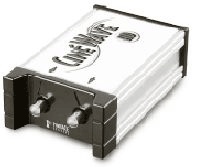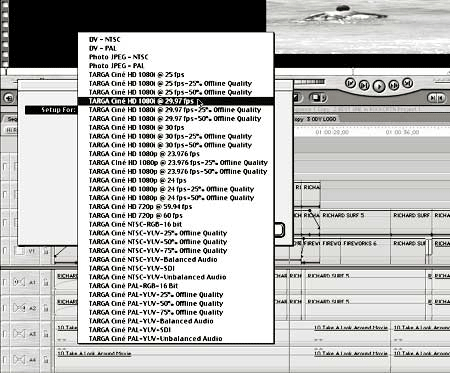
![]()
![]()
Pinnacle Systems CinéWave is a hardware/software package used with Apple Final Cut Pro 3, that can perform uncompressed standard-definition and high-definition editing and finishing at a surprisingly low cost. Prices range from $5,495 for the most basic system to
|
|
|
|
Figure 1. The Targa Ciné card. Its two connectors attach to break-out boxes that provide input and output ports. |
|
The CinéWave system runs on an Apple Power Mac G4 (either a desktop or a laptop with an expansion chassis) and includes the following software: Final Cut Pro 3, Pinnacle Commotion Pro and Knoll Light Factory. It also includes Pinnacle's Targa Ciné Engine PCI card (Figure 1), as well as a Stealth card from GeeThree, which replaces the internal modem of the G4 and is used for serial deck control.
Media are input and output through breakout boxes (BOBs) which are attached to the CinéWave card (Figures 2 and 4). The system can support one or two BOBs attached simultaneously. Four are available: Pro Analog, Pro Digital, Pro HD Digital and Pro Digital and Analog. Together, they allow the system to handle all standard and high-definition video formats -- analog or digital. The digital BOBs employ a simple connection system with only three cables: deck control and SDI or SDTI (serial-digital) in and out. This greatly reduces setup time. The digital connector is a single BNC-to-BNC cable, which carries the uncompressed video and two cha nnels of digital audio. (The CinéWave HD BOB can actually carry four channels of digital audio, but at the moment, FCP can handle a maximum of two.) CinéWave's modular design means that you can buy a base-level system and upgrade it just by replacing the breakout box.
The optional CinéWaveRT software allows the system to handle two-stream, real-time standard-definition effects, with two additional streams of real-time graphics. Because the hardware is Apple QuickTime native, any application that uses QuickTime (including Adobe After Effects) can output through the CinéWave hardware. However, CinéWave does not work with video captured via FireWire; those clips must be rendered in the timeline to make them CinéWave compatible.
This same system can also produce commercial grade DVDs using DVD Studio Pro. And if you use Flash to make animated projects, you can export them as a standard or high-definition QuickTime movies, then use CinéWave and FCP to output them in any uncompressed video format. Commotion Pro integrates into Final Cut and offers wire removal, compositing and other 2D processing for both standard and high-definition projects.
After you install CinéWave, a number of new set-up options appear in Final Cut Pro, allowing you to configure it to work in several offline and online resolutions, including 1080i at 24, 29.97 or 30 fps and 1080p at 23.976 or 24 fps, as well as standard-definition 10-bit NTSC/YUV, PAL and 16-bit RGB. (See Figure 3. Note that the system will work at 720p but timecodes will be inaccurate. This is expected to be fixed in the future.) Because Final Cut can import EDLs in many standard formats, the system can be used not only for editing, but as a finishing station in conjunction with any offline system that can generate an EDL.
To test CinéWave's video quality, I performed a series of experiments using uncompressed
|
|
|
|
Figure 2. One of the four break-out boxes available for CinéWave. This one, the Pro HD Digital, enables the input and output of uncompressed HD video. |
|
To examine its standard-def capabilities, I connected it to a DigiBeta deck controlled by the system's Stealth serial card. I then imported an EDL from a Symphony, which Final Cut converted into a sequence in the timeline.
To capture media, I control-clicked on the sequence and selected Capture. FCP opened a window and processed the file into a list of tapes and clips. I selected the reels I wanted to load, and FCP captured the necessary clips and inserted them into the timeline. All elements came in frame-accurately, including fades, which played without having to be rendered. The RT system's real-time capabilities are very robust and responsive and include a very wide range of keyframeable filters and motion controls.
Visually, there was no difference between the output of the FCP/CinéWave system and that of the Avid Symphony. When I looked at the output of both on a freshly calibrated Tektronix scope, both showed identical waveforms.
When I did my high-definition tests, I was able to take advantage of some of the resources available at the Fox DTV Lab, which was established to experiment with new forms of television technology, including high-definition. Jim DeFilippis, vice president of television engineering, gave me access to the lab's HD gear. I used a Sony Trinitron HD monitor, two Panasonic HD (D5 and DVCPRO) decks and an Astro WM3001 HD waveform monitor.
|
|
|
Figure 3. After
CinéWave is installed, new set-up options
appear in Final Cut Pro, |
With CinéWave hardware, Final Cut Pro captured, edited and rendered effects flawlessly at 1080i. Because the system pushes the price/performance envelope, I had expected some problems, but encountered none. When working in HD, CinéWave does not allow real-time effects, but after rendering, my effects looked excellent. When I compared the original source footage to the CinéWave output, there was no noticeable difference, either on the scope or to the eye.
Final Cut's new compressed OfflineRT resolution allows the use of the slowest drives, making shared storage easier to set up. Both OfflineRT and DV work well with standard ATA drives,
|
|
|
|
Figure 4. The Pro Digital and Analog Breakout Box provides a wide array of I/O options for audio and standard definition video. |
|
Uncompressed SD video is much more demanding, and typically requires several fast SCSI drives in a RAID configuration with an Ultra 160 card. Uncompressed HD needs an even more robust RAID, typically with a dual channel, Ultra160 interface. I used Seagate Cheetah 10k drives in a MaxArray from Rorke Data with an ATTO UL3D SCSI card, all of which worked without a hitch. I also successfully used Huge Systems' low-cost HugeMediaVault-400-DualMax for both SD and HD editing.
CinéWave demonstrates the scalability of Apple's Final Cut Pro strategy: The system can be used to cut anything from low-quality offline material to full-res high-definition video ready for air. Regardless of resolution, the user interface and basic feature set is the same, so you can learn the system on a laptop and quickly feel comfortable in a full HD environment. Final Cut is not an Avid, however and Guild members may find themselves missing various things, including some film and multi-cam functionality and other features. As a finishing system, Symphony imports Avid bins directly, so all effects are brought in without change. Final Cut opens its own projects perfectly but if you want to import from an Avid, you'll have to do it via an EDL and some effects will be left behind. But the Symphony is a pure standard-definition system. If you want an HD solution from Avid, you must move up to the even more expensive Softimage DS|HD.
However, these kinds of comparisons are really beside the point. FCP/CinéWave establishes a new price/performance benchmark. It is designed to produce excellent quality SD and HD outputs in a simple and flexible hardware environment at surprisingly low cost. I found it easy to use, and the results were technically excellent. I would have no hesitation using this system to edit and finish a project in either standard or high definition.
Copyright © 1996-2001
The Motion Picture Editors Guild, IATSE Local 700, All Rights Reserved



